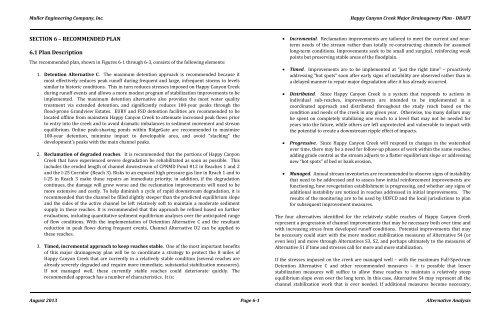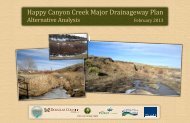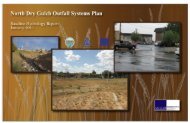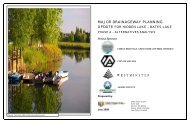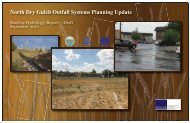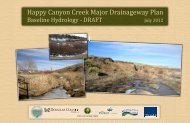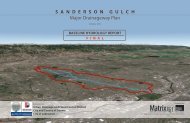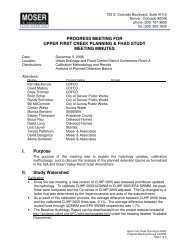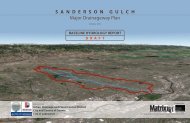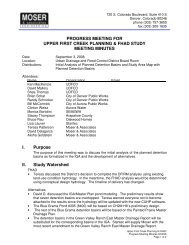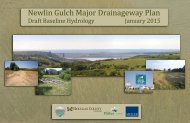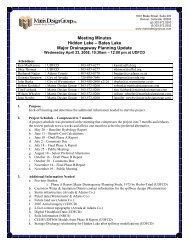PDF (53.8 MB) - Urban Drainage and Flood Control District
PDF (53.8 MB) - Urban Drainage and Flood Control District
PDF (53.8 MB) - Urban Drainage and Flood Control District
You also want an ePaper? Increase the reach of your titles
YUMPU automatically turns print PDFs into web optimized ePapers that Google loves.
Muller Engineering Company, Inc.<br />
Happy Canyon Creek Major <strong>Drainage</strong>way Plan - DRAFT<br />
SECTION 6 – RECOMMENDED PLAN<br />
6.1 Plan Description<br />
The recommended plan, shown in Figures 6-1 through 6-3, consists of the following elements:<br />
1. Detention Alternative C. The maximum detention approach is recommended because it<br />
most effectively reduces peak runoff during frequent <strong>and</strong> large, infrequent storms to levels<br />
similar to historic conditions. This in turn reduces stresses imposed on Happy Canyon Creek<br />
during runoff events <strong>and</strong> allows a more modest program of stabilization improvements to be<br />
implemented. The maximum detention alternative also provides the most water quality<br />
treatment via extended detention, <strong>and</strong> significantly reduces 100-year peaks through the<br />
flood-prone Gr<strong>and</strong>view Estates. EURV <strong>and</strong> FSD detention facilities are recommended to be<br />
located offline from mainstem Happy Canyon Creek to attenuate increased peak flows prior<br />
to entry into the creek <strong>and</strong> to avoid dramatic imbalances in sediment movement <strong>and</strong> stream<br />
equilibrium. Online peak-shaving ponds within RidgeGate are recommended to maximize<br />
100-year detention, minimize impact to developable area, <strong>and</strong> avoid “stacking” the<br />
development’s peaks with the main channel peaks.<br />
2. Reclamation of degraded reaches. It is recommended that the portions of Happy Canyon<br />
Creek that have experienced severe degradation be rehabilitated as soon as possible. This<br />
includes the eroded length of channel downstream of CPNMD Pond #12 in Reaches 1 <strong>and</strong> 2<br />
<strong>and</strong> the I-25 Corridor (Reach 3). Risks to an exposed high pressure gas line in Reach 1 <strong>and</strong> to<br />
I-25 in Reach 3 make these repairs an immediate priority; in addition, if the degradation<br />
continues, the damage will grow worse <strong>and</strong> the reclamation improvements will need to be<br />
more extensive <strong>and</strong> costly. To help diminish a cycle of rapid downstream degradation, it is<br />
recommended that the channel be filled slightly steeper than the predicted equilibrium slope<br />
<strong>and</strong> the sides of the active channel be left relatively soft to maintain a moderate sediment<br />
supply in these reaches. It is recommended that this approach be refined based on further<br />
evaluations, including quantitative sediment equilibrium analyses over the anticipated range<br />
of flow conditions. With the implementation of Detention Alternative C <strong>and</strong> the resultant<br />
reduction in peak flows during frequent events, Channel Alternative D2 can be applied to<br />
these reaches.<br />
3. Timed, incremental approach to keep reaches stable. One of the most important benefits<br />
of this major drainageway plan will be to coordinate a strategy to protect the 8 miles of<br />
Happy Canyon Creek that are currently in a relatively stable condition (several reaches are<br />
already severely degraded <strong>and</strong> require more immediate, substantial stabilization measures).<br />
If not managed well, these currently stable reaches could deteriorate quickly. The<br />
recommended approach has a number of characteristics. It is:<br />
• Incremental. Reclamation improvements are tailored to meet the current <strong>and</strong> nearterm<br />
needs of the stream rather than totally re-constructing channels for assumed<br />
long-term conditions. Improvements seek to be small <strong>and</strong> surgical, reinforcing weak<br />
points but preserving stable areas of the floodplain.<br />
• Timed. Improvements are to be implemented at “just the right time” – proactively<br />
addressing “hot spots” soon after early signs of instability are observed rather than in<br />
a delayed manner to repair major degradation after it has already occurred.<br />
• Distributed. Since Happy Canyon Creek is a system that responds to actions in<br />
individual sub-reaches, improvements are intended to be implemented in a<br />
coordinated approach <strong>and</strong> distributed throughout the study reach based on the<br />
condition <strong>and</strong> needs of the creek in any given year. Otherwise, too many dollars may<br />
be spent on completely stabilizing one reach to a level that may not be needed for<br />
years into the future, while others are left unprotected <strong>and</strong> vulnerable to impact with<br />
the potential to create a downstream ripple effect of impacts.<br />
• Progressive. Since Happy Canyon Creek will respond to changes in the watershed<br />
over time, there may be a need for follow-up phases of work within the same reaches,<br />
adding grade control as the stream adjusts to a flatter equilibrium slope or addressing<br />
new “hot spots” of bed or bank erosion.<br />
• Managed. Annual stream inventories are recommended to observe signs of instability<br />
that need to be addressed <strong>and</strong> to assess how initial reinforcement improvements are<br />
functioning, how revegetation establishment is progressing, <strong>and</strong> whether any signs of<br />
additional instability are noticed in reaches addressed in initial improvements. The<br />
results of the monitoring are to be used by UDFCD <strong>and</strong> the local jurisdictions to plan<br />
for subsequent improvement measures.<br />
The four alternatives identified for the relatively stable reaches of Happy Canyon Creek<br />
represent a progression of channel improvements that may be necessary both over time <strong>and</strong><br />
with increasing stress from developed runoff conditions. Potential improvements that may<br />
be necessary could start with the more modest stabilization measures of Alternative S4 (or<br />
even less) <strong>and</strong> move through Alternatives S3, S2, <strong>and</strong> perhaps ultimately to the measures of<br />
Alternative S1 if time <strong>and</strong> stresses call for more <strong>and</strong> more stabilization.<br />
If the stresses imposed on the creek are managed well – with the maximum Full-Spectrum<br />
Detention Alternative C <strong>and</strong> other recommended measures – it is possible that lesser<br />
stabilization measures will suffice to allow these reaches to maintain a relatively steep<br />
equilibrium slope even over the long term. In this case, Alternative S4 may represent all the<br />
channel stabilization work that is ever needed. If additional measures become necessary,<br />
August 2013 Page 6-1 Alternative Analysis


